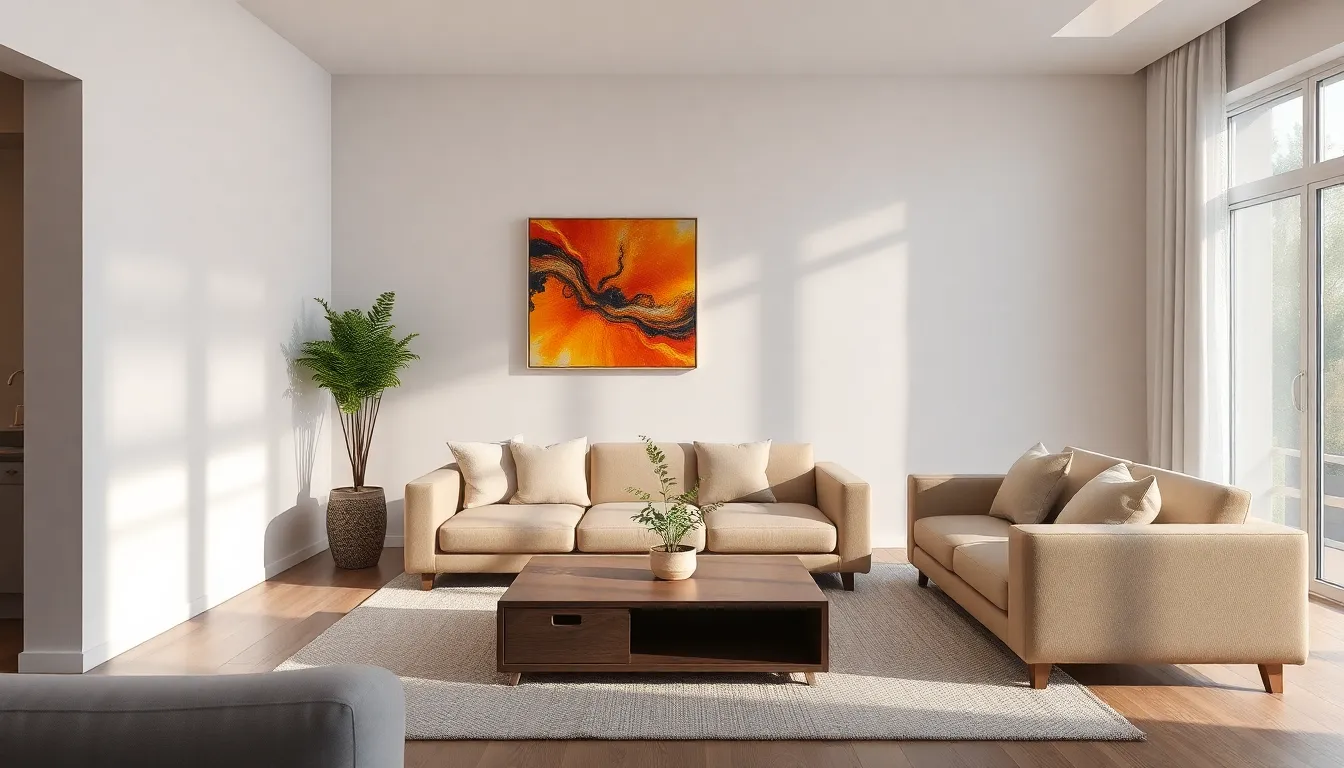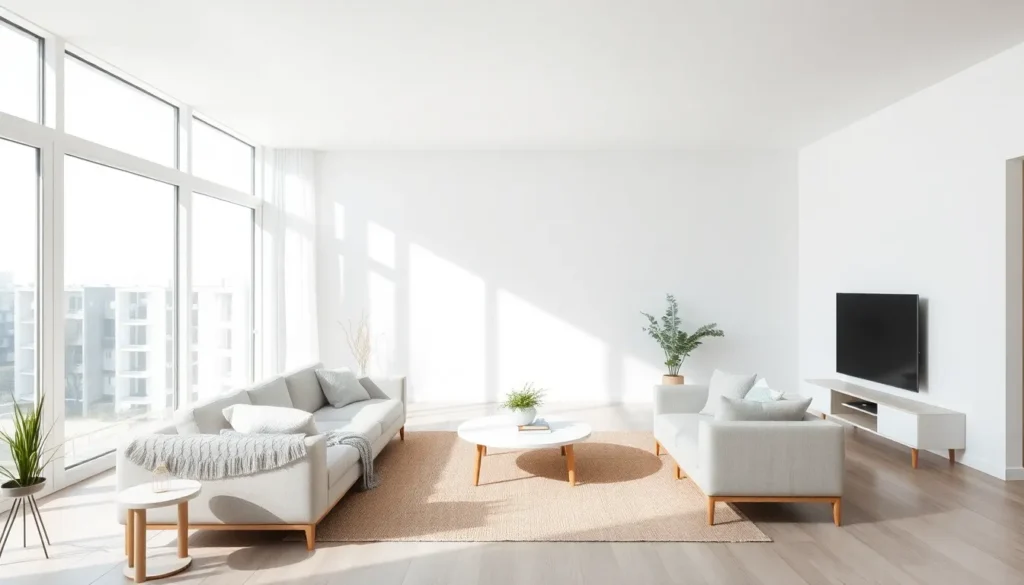Table of Contents
ToggleIn a world overflowing with possessions and distractions, the minimalist home offers a refreshing escape. This design philosophy embraces simplicity, focusing on functionality and beauty while eliminating clutter. By prioritizing essential items, individuals can create serene spaces that foster peace and clarity.
Minimalism isn’t just about aesthetics; it’s a lifestyle choice that promotes intentional living. By surrounding themselves with only what truly matters, homeowners can experience reduced stress and increased mindfulness. As the trend gains momentum, more people are discovering the transformative power of minimalism in their living environments. Whether it’s a cozy apartment or a spacious house, adopting a minimalist approach can lead to a more fulfilling and harmonious life.
What Is a Minimalist Home?
A minimalist home emphasizes simplicity, functionality, and intentionality. It prioritizes essential items and thoughtful design, creating spaces that reflect personal values and reduce distractions.
Definition and Key Principles
A minimalist home focuses on reducing clutter while maximizing space. Key principles include:
- Less is More: Prioritizing fewer possessions over quantity encourages thoughtful choices.
- Functionality: Each item serves a purpose, enhancing the home’s usability.
- Simplicity: Clean lines and neutral color palettes create a serene environment.
- Intentional Living: Mindful decisions about belongings foster a lifestyle aligned with personal values.
Benefits of Minimalism in Home Design
- Reduced Stress: Clutter-free spaces promote tranquility and peace of mind.
- Increased Space: Open layouts contribute to a feeling of spaciousness, making homes more breathable.
- Easier Maintenance: Fewer items result in less cleaning and upkeep.
- Cost-Effectiveness: Investing in quality over quantity can lead to long-term savings.
- Enhanced Focus: Minimal distractions lead to improved concentration and productivity.
Essential Elements of a Minimalist Home

A minimalist home prioritizes simplicity and functionality, encompassing design choices that reflect these principles. Essential elements contribute to a serene and intentional living environment.
Color Palette
Color choices play a significant role in establishing a minimalist atmosphere. Neutral tones dominate, including shades like white, gray, and beige, which create an open and airy feeling. Accent colors can emerge through small, intentional selections, such as a single piece of artwork or a bold cushion, ensuring harmony without overwhelming the space. This strategic approach enhances visual clarity while maintaining an inviting ambiance.
Furniture Choices
Furniture in a minimalist home focuses on quality over quantity. Selecting multi-functional pieces, such as a coffee table with storage space or a sofa bed, optimizes functionality. Low-profile designs create a sense of spaciousness, while natural materials, like wood and metal, contribute warmth and texture. Limitations on the number of furniture items foster an uncluttered environment, encouraging mindfulness and ease of movement.
Decor and Accessories
Decor and accessories in minimalist settings serve specific purposes and maintain a cohesive look. Choosing a few curated items enhances personal style without inducing visual chaos. Incorporating plants adds a touch of nature and liveliness. Artwork remains impactful when limited, utilizing one or two statement pieces rather than overwhelming wall space. Prioritizing functional accessories, like a stylish clock or a definition-driven rug, maintains the minimalist ethos while adding character.
Creating a Minimalist Home
Creating a minimalist home involves intentional choices focused on simplicity and functionality. The following steps provide a clear guide to achieving a serene living environment.
Decluttering and Organizing
Decluttering is essential for a minimalist home. Start by evaluating every item based on necessity and emotional value. Discard items that do not serve a purpose or evoke joy. Organizing belongings keeps spaces functional. Use storage solutions that maintain a streamlined appearance, such as built-in shelves or multi-functional furniture. Each item should have a designated space, ensuring a clutter-free environment.
Choosing the Right Layout
Choosing an effective layout enhances minimalist principles. Prioritize open spaces to promote flow and accessibility. Arrange furniture to create comfortable traffic paths, avoiding overcrowding. Consider zoning areas for specific activities, like relaxation or work, while keeping transitions seamless. An effective layout increases functionality and contributes to an overall sense of tranquility.
Incorporating Natural Light
Incorporating natural light transforms minimalist spaces significantly. Maximize windows to allow ample sunlight, promoting warmth and openness. Choose sheer curtains or no window treatments to enhance brightness. Reflective surfaces, like mirrors, can amplify light, making spaces feel larger. Natural light not only elevates aesthetics but also improves mood, aligning with the core ideals of minimalist living.
Challenges of Embracing Minimalism
Embracing minimalism comes with its unique set of challenges. While the concept promotes intentional living, individuals often face hurdles that require sustained effort to overcome.
Overcoming Emotional Attachments
Overcoming emotional attachments to possessions presents significant challenges. People frequently associate items with memories, relationships, and sentiments. To let go, individuals can try these strategies:
- Recognizing the attachment: Acknowledge the emotions linked to items before deciding to keep or discard them.
- Journaling: Writing about the significance of items helps clarify their importance and reduces attachment.
- Setting boundaries: Limit the number of sentimental items to maintain focus on essentials.
- Reframing perspectives: Shifting beliefs about belongings can ease the letting go process—view items as temporary rather than permanent.
Maintaining Minimalism Over Time
Maintaining minimalism requires consistent effort and intentionality. The clutter-free lifestyle can fade if not actively nurtured. Individuals can follow these practices:
- Regular decluttering: Schedule periodic evaluations of possessions, ideally monthly or quarterly, to reassess the necessity of items.
- Mindful shopping: Prioritize quality over quantity when adding new items, ensuring they align with minimalist values.
- Setting goals: Establish specific, achievable goals for maintaining minimalism, such as limiting new purchases to a set number per month.
- Creating a supportive environment: Engage with like-minded individuals or communities that encourage and inspire minimalist practices.
With focused strategies for overcoming emotional attachments and sustaining minimalism, individuals can navigate the challenges and enjoy the benefits of a simplified lifestyle.
Embracing a minimalist home can lead to profound changes in one’s life. By prioritizing simplicity and intentionality, individuals can create spaces that not only look beautiful but also promote mental clarity and emotional well-being. The journey toward minimalism involves thoughtful choices and a commitment to maintaining a clutter-free environment.
As more people discover the transformative power of minimalism, they find that less truly can be more. A minimalist lifestyle encourages a deeper connection to what matters most, fostering a sense of peace and fulfillment that transcends material possessions. Adopting these principles can ultimately pave the way for a more harmonious and enriched living experience.







